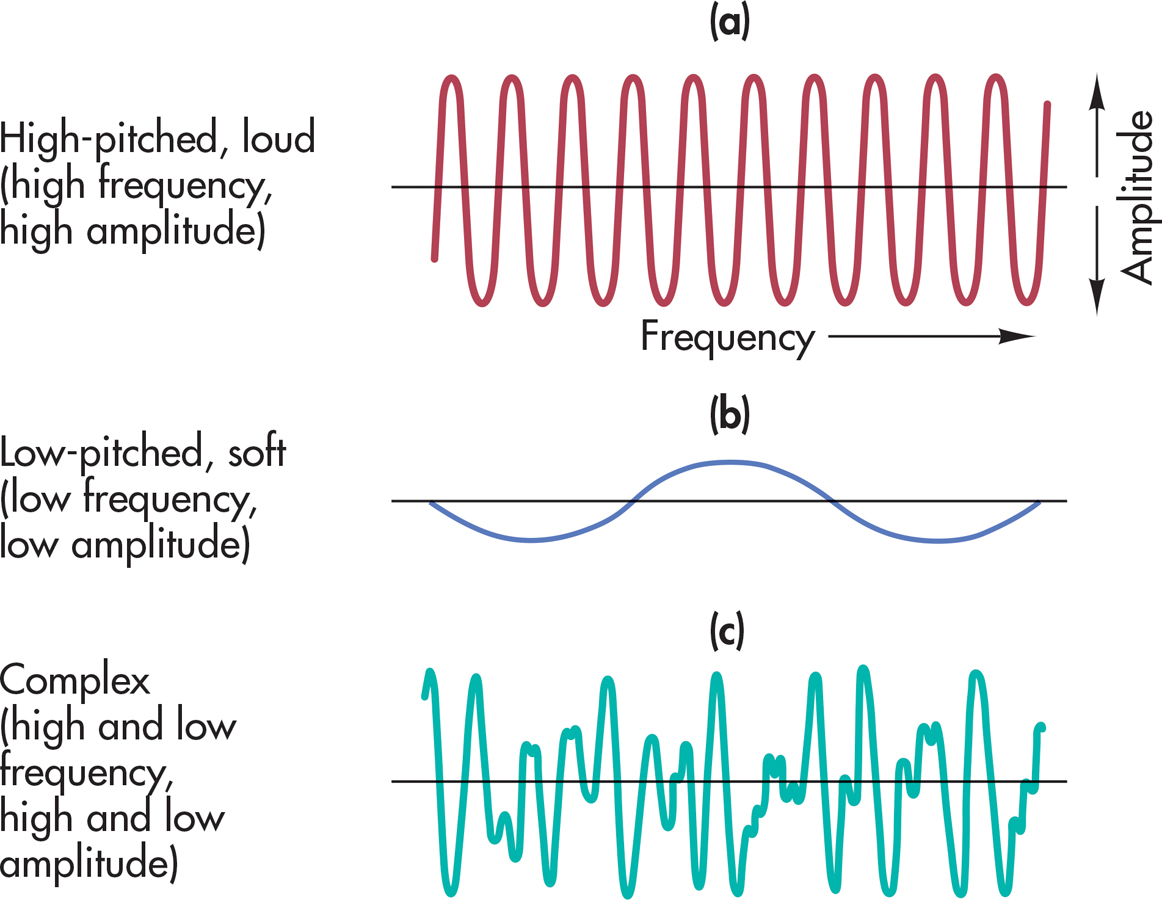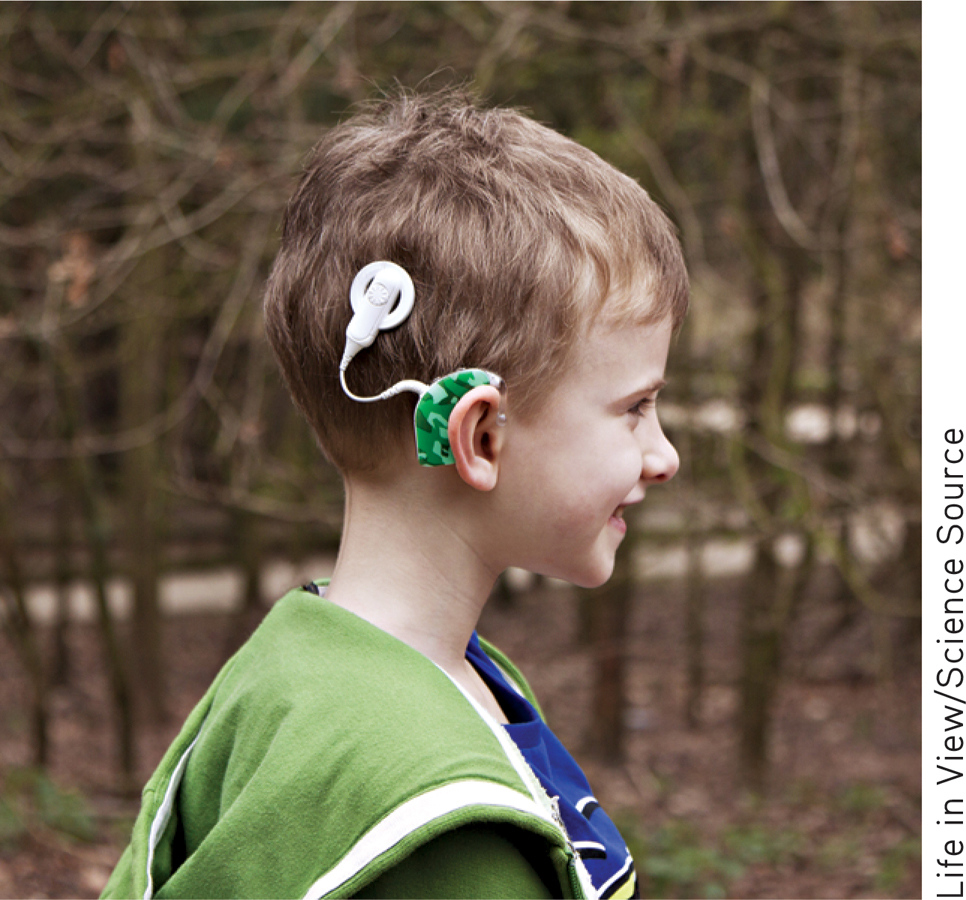3.3 Hearing: FROM VIBRATION TO SOUND
KEY THEME
Auditory sensation, or hearing, results when sound waves are collected in the outer ear, amplified in the middle ear, and converted to neural messages in the inner ear.
KEY QUESTIONS
How do sound waves produce different auditory sensations?
What are the key structures of the ear and their functions?
How do place theory and frequency theory explain pitch perception?
Your author Sandy has hiked in a desert area that was so quiet she could hear the whir of a single grasshopper’s wings in the distance. And she has waited on a subway platform where the screech of metal wheels against metal rails forced her to cover her ears.
The sense of hearing, or audition, is capable of responding to a wide range of sounds, from faint to blaring, simple to complex, harmonious to discordant. The ability to sense and perceive very subtle differences in sound is important to physical survival, social interactions, and language development. Most of the time, all of us are bathed in sound—so much so that moments of near-silence, like Sandy’s experience in the desert, can seem almost eerie.
audition
The technical term for the sense of hearing.
What We Hear: THE NATURE OF SOUND
Whether it’s the ear-splitting screech of metal on metal or the subtle whir of a grasshopper’s wings, sound waves are the physical stimuli that produce our sensory experience of sound. Usually, sound waves are produced by the rhythmic vibration of air molecules, but sound waves can be transmitted through other media, such as water, too. Our perception of sound is directly related to the physical properties of sound waves (see FIGURE 3.7).

One of the first things that we notice about a sound is how loud it is. Loudness is determined by the intensity, or amplitude, of a sound wave and is measured in units called decibels. Zero decibels represents the loudness of the softest sound that humans can hear, or the absolute threshold for hearing. As decibels increase, perceived loudness increases.
loudness
The intensity (or amplitude) of a sound wave, measured in decibels.
amplitude
The intensity or amount of energy of a wave, reflected in the height of the wave; the amplitude of a sound wave determines a sound’s loudness.
decibel
(DESS-uh-bell) The unit of measurement for loudness.
Pitch refers to the relative “highness” or “lowness” of a sound. Pitch is determined by the frequency of a sound wave. Frequency refers to the rate of vibration, or number of waves per second, and is measured in units called hertz. Hertz simply refers to the number of wave peaks per second. The faster the vibration, the higher the frequency, the closer together the waves are—and the higher the tone produced. If you pluck the high E and the low E strings on a guitar, you’ll notice that the low E vibrates far fewer times per second than does the high E.
pitch
The relative highness or lowness of a sound, determined by the frequency of a sound wave.
frequency
The rate of vibration, or the number of sound waves per second.
Most of the sounds we experience do not consist of a single frequency but are complex, consisting of several sound-wave frequencies. This combination of frequencies produces the distinctive quality, or timbre, of a sound, which enables us to distinguish easily between the same note played on a saxophone and on a piano. Every human voice has its own distinctive timbre, which is why you can immediately identify a friend’s voice on the telephone from just a few words, even if you haven’t talked to each other for years.
timbre
(TAM-ber) The distinctive quality of a sound, determined by the complexity of the sound wave.
How We Hear: THE PATH OF SOUND
The ear is made up of the outer ear, the middle ear, and the inner ear. Sound waves are collected in the outer ear, amplified in the middle ear, and transduced, or transformed into neural messages, in the inner ear (see FIGURE 3.8 below).

The outer ear includes the pinna, the ear canal, and the eardrum. The pinna is that oddly shaped flap of skin and cartilage that’s attached to each side of your head. The pinna helps us pinpoint the location of a sound. But the pinna’s primary role is to catch sound waves and funnel them into the ear canal. The sound wave travels down the ear canal and then bounces into the eardrum, a tightly stretched membrane. When the sound wave hits the eardrum, the eardrum vibrates, matching the vibrations of the sound wave in intensity and frequency.
outer ear
The part of the ear that collects sound waves; consists of the pinna, the ear canal, and the eardrum.
eardrum
A tightly stretched membrane at the end of the ear canal that vibrates when hit by sound waves.

The eardrum separates the outer ear from the middle ear. The eardrum’s vibration is transferred to three tiny bones in the middle ear—the hammer, the anvil, and the stirrup. Each bone sets the next bone in motion. The joint action of these three bones almost doubles the amplification of the sound. The innermost bone, the stirrup, transmits the amplified vibration to the oval window. If the tiny bones of the middle ear are damaged or become brittle, as they sometimes do in old age, conduction deafness may result. Conduction deafness can be helped by a hearing aid, which amplifies sounds.
middle ear
The part of the ear that amplifies sound waves; consists of three small bones: the hammer, the anvil, and the stirrup.
Like the eardrum, the oval window is a membrane, but it is many times smaller than the eardrum. The oval window separates the middle ear from the inner ear. As the oval window vibrates, the vibration is next relayed to an inner structure called the cochlea, a fluid-filled tube that’s coiled in a spiral. The word cochlea comes from the Greek word for “snail,” and the spiral shape of the cochlea does resemble a snail’s shell. Although the cochlea is a very complex structure, it is quite tiny—no larger than a pea.
inner ear
The part of the ear where sound is transduced into neural impulses; consists of the cochlea and semicircular canals.
cochlea
(COKE-lee-uh) The coiled, fluid-filled inner-ear structure that contains the basilar membrane and hair cells.
As the fluid in the cochlea ripples, the vibration in turn is transmitted to the basilar membrane, which runs the length of the coiled cochlea. Embedded in the basilar membrane are the sensory receptors for sound, called hair cells, which have tiny, projecting fibers that look like hairs. Damage to the hair cells or auditory nerve can result in nerve deafness. Exposure to loud noise can cause nerve deafness (see TABLE 3.2). Hearing aids are of no use in this form of deafness because the neural messages cannot reach the brain. However, nerve deafness can, in some cases, be treated with a cochlear implant, which is an electronic device surgically implanted behind the ear (see photo).
basilar membrane
(BAZ-uh-ler or BAYZ-uh-ler) The membrane within the cochlea of the ear that contains the hair cells.
hair cells
The hair-like sensory receptors for sound, which are embedded in the basilar membrane of the cochlea.
Decibel Levels of Some Common Sounds
| Decibels | Examples | Exposure Danger |
|---|---|---|
| 180 | Rocket launching pad | Hearing loss inevitable |
| 140 | Shotgun blast, jet plane | Any exposure is dangerous |
| 120 | Speakers at rock concert, sandblasting, thunderclap | Immediate danger |
| 100 | Chain saw, pneumatic drill | 2 hours |
| 90 | Truck traffic, noisy home appliances, lawn mower | Less than 8 hours |
| 80 | Subway, heavy city traffic, alarm clock at 2 feet | More than 8 hours |
| 70 | Busy traffic, noisy restaurant | Critical level begins with constant exposure |
| 60 | Air conditioner at 20 feet, conversation, sewing machine | |
| 50 | Light traffic at a distance, refrigerator | |
| 40 | Quiet office, living room | |
| 30 | Quiet library, soft whisper | |
| 0 | Lowest sound audible to human ear |

The hair cells bend as the basilar membrane ripples. It is here that transduction finally takes place: The physical vibration of the sound waves is converted into neural impulses. As the hair cells bend, they stimulate the cells of the auditory nerve, which carries the neural information to the thalamus and the auditory cortex in the brain (Hackett & Kaas, 2009; Recanzone & Sutter, 2008).

DISTINGUISHING PITCH
How do we distinguish between the low-pitched throb of a bass guitar and the high-pitched tones of a piccolo? Remember, pitch is determined by the frequency of a sound wave. The basilar membrane is a key structure involved in our discrimination of pitch. Two complementary theories describe the role of the basilar membrane in the transmission of differently pitched sounds.
According to frequency theory, the basilar membrane vibrates at the same frequency as the sound wave. Thus, a sound wave of about 100 hertz would excite each hair cell along the basilar membrane to vibrate 100 times per second, and neural impulses would be sent to the brain at the same rate. However, there’s a limit to how fast neurons can fire. Individual neurons cannot fire faster than about 1,000 times per second. But we can sense sounds with frequencies that are many times higher than 1,000 hertz. A child, for example, can typically hear pitches ranging from about 20 to 20,000 hertz.
frequency theory
The view that the basilar membrane vibrates at the same frequency as the sound wave.
So how can higher-frequency sounds be transmitted? A partial explanation involves the volley principle, which draws upon a military strategy developed before the development of modern firearms. To deal with the problem of slow reload times, different groups of soldiers would fire in sequence to minimize the amount of time between “volleys” of bullets launched at the enemy.
The volley principle holds that hair cells also fire in “volleys.” Imagine three groups of neurons, each of which can fire at a rate of 1,000 times per second. But rather than firing in unison, the neuron groups take turns, each group firing in rapid succession while the other groups are in the resting state. In this way, impulses can be sent to the brain at rates that exceed 1,000 impulses per second.

So how do we hear higher-pitched sounds above 3,000 hertz? According to place theory, different frequencies cause larger vibrations at different locations along the basilar membrane. High-frequency sounds, for example, cause maximum vibration near the stirrup end of the basilar membrane. Lower-frequency sounds cause maximum vibration at the opposite end. Thus, different pitches excite different hair cells along the basilar membrane. Higher-pitched sounds are interpreted according to the place where the hair cells are most active.
place theory
The view that different frequencies cause larger vibrations at different locations along the basilar membrane.
Both frequency theory and place theory are involved in explaining our discrimination of pitch (Kaas & others, 2013). Frequency theory helps explain our discrimination of low frequencies. Place theory helps explain our discrimination of higher-pitched sounds. For intermediate frequencies or midrange pitches, both place and frequency are involved.